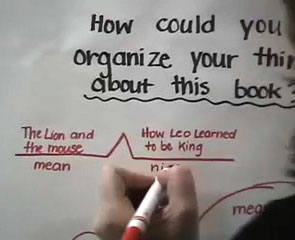



Mt. Airy Elementary School: Case Study
Mt. Airy, Maryland
Organizing Our Thinking
While observing Ms. Crystal Smith's classroom, I sat down behind the students: As principal and instructional leader, I began clacking away notes on my laptop. Students gathered on the floor near their teacher, just below the blank, open space on the chalkboard that held the guiding question for discussion. The book How Leo Learned to Be King had been read aloud the day before, but the students and all of the teachers and administrators across our school had learned about Thinking Maps the year before. These excerpts and the related maps may heighten your understanding of Thinking Maps and still underrepresent the richness of the classroom conversation. Here is how first graders organized their thinking about this book:
Erin: You could use the Circle Map . . . put the topic in the middle and all ideas that you get in your mind from that topic, you write down in the circle. . . Leo . . . details about Leo. . . he was mean and he was nice.
Megan: A Bubble Map about a mouse. You say a word about what the mouse is . . . like furry . . . describing words.
Billy: We could do a Double Bubble. We could compare How Leo Learned to Be King and The Lion and the Mouse. . . . they (both books) both have a lion and a mouse.
Mark: A Tree Map. I am thinking of. . . about Leo. . . what he looks like . . . and, urn, I think, and what he is like . . . and what he did.
Thomas: You could organize it with a Bridge Map. In The Lion and the Mouse, the lion was mean to the mouse, but in How Leo Learned to Be King, the lion was nice to the mouse by helping him get over the river.
Alexis: You could use a Flow Map. First he was mean. Then when they took off the crown he, like, got a little embarrassed. He walked away, he got surprised, because he met a mouse. And at the end he helped the mouse and they became friends.
Regan: Multi-Flow . . . what caused him to be mean. The crown made . . . the crown could have caused him to be mean.
Erin: No one liked him. They took away. . . they didn't want him to be their king.
Shawn: We've got a lot of maps, don't we?
Teacher: That makes me think. . .
Shawn: . . . that we are like second graders!
Organize Our Thinking in a First Grade Classroom

Watch the Mt. Airy first-grade classroom organize their thinking using different Thinking Maps to share insights into the book Leo the Lion, then use the Thinking Map that best suits their thinking and learning styles individually. More information about Mt. Airy Elementary School is part of the book Student Successes With Thinking Maps
The discussion among Ms. Smith and her students is within reach of any school, replicable, and may refine and even reframe reading and writing instruction, and even offer a new direction for cognitive science research. This teacher had brought students to such a high level of fluency with Thinking Maps that they could begin to identify text patterns on their own. They were able to use fundamental thinking-skills vocabulary (describing, compare, causes, etc.) and respective cognitive maps (Bubble, Double Bubble, Multi-Flow, etc.) and had the metacognitive awareness of being able to explicitly transfer these processes and tools to reading comprehension through identifying text structures. They were then able to return to their seats with blank sheets of paper and, with varying results, choose a Thinking Map and expand their thinking. They later went on to write about the story using the maps they had chosen to organize their ideas.
This sample of classroom activity is a practical and symbolic representation of a new form of literacy and a transformation of how we perceive the interrela tionships between thinking patterns and the fundamentals of reading comprehension.
Examples of the student's Thinking Maps:
![]() Download the above image as a PDF file
Download the above image as a PDF file